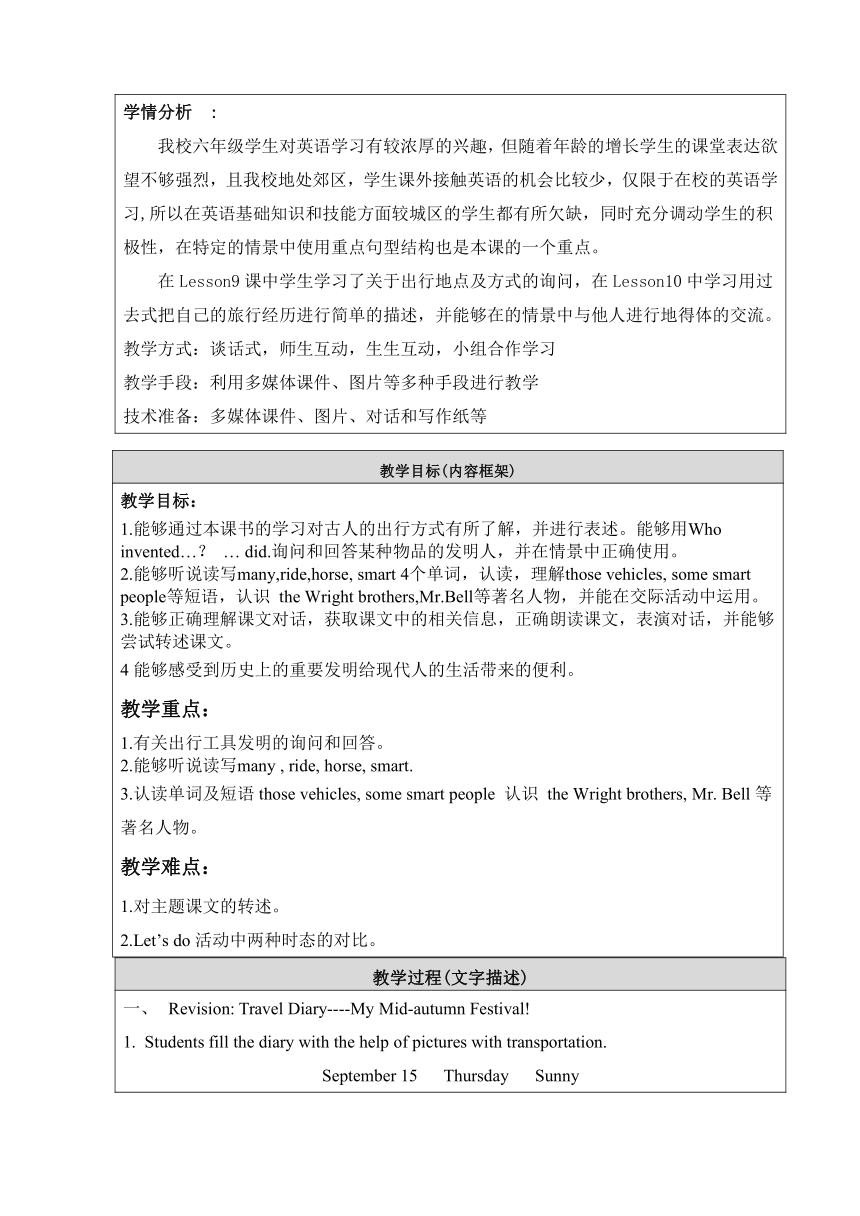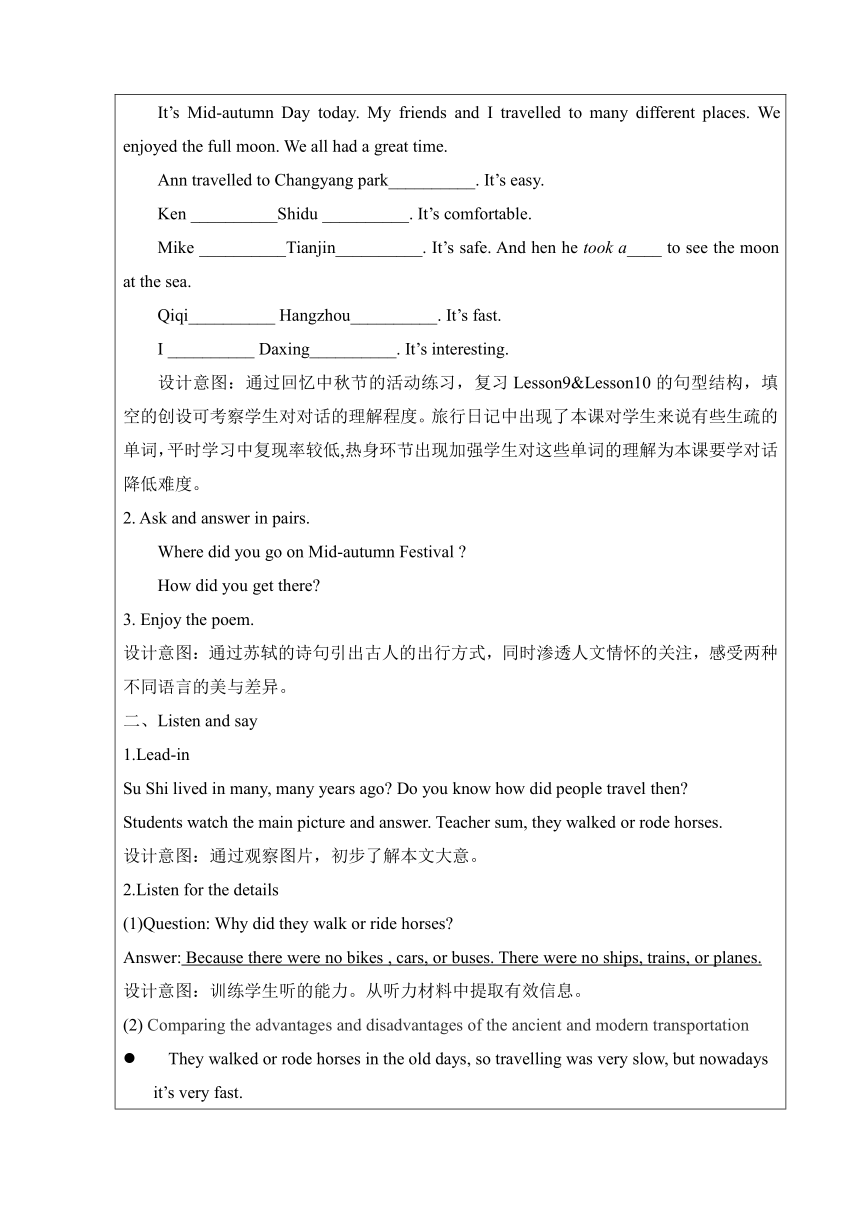Unit 3 How did you go to Hangzhou? Lesson 11 表格式教案
文档属性
| 名称 | Unit 3 How did you go to Hangzhou? Lesson 11 表格式教案 |  | |
| 格式 | zip | ||
| 文件大小 | 15.8KB | ||
| 资源类型 | 教案 | ||
| 版本资源 | 北京版 | ||
| 科目 | 英语 | ||
| 更新时间 | 2019-08-20 08:39:01 | ||
图片预览



文档简介
教学基本信息
课题
Unit3How did you go to Hangzhou? Lesson11
是否属于地方
课程或校本课程
否
学科
英语
学段: 高年级
年级
六年级
相关领域
出行方式
教材
出版社:北京出版社 出版日期:2014年 7 月
教学设计参与人员
姓名
单位
联系方式
设计者
实施者
指导者
课件制作者
其他参与者
指导思想与理论依据
根据英语课程二级目标的要求,基于促进学生全面发展的基本理念,以培养学生的综合语言运用能力为目标,在培养学生英语语言能力的同时进一步促进学生思维能力的提高,促进学生在语言、情感、认知、文化意识、学习能力、道德与价值观等多方面的综合发展。结合以上内容要求及本校六年级学生的实际情况设计本课,旨在培养学生在特定情景中恰当运用语言的能力。
教学背景分析
教材分析?:
本单元是关于过去发生的事情或者进行的活动的表达。学生已经系统学过特殊疑问句的句式;在前面课文复习了过去式的用法和结构;以上的上位知识都对新知学习起到加强和巩固作用。本单元教学重点是在相应情景下能把以上各知识点综合起来就过去做某事、发明创造的话题灵活地进行运用。
本课侧重对发明事物的描述并借助对古人出行方式的学习,帮助学生以积极的情感感受现代文明带给人们的便捷。本课要求学生能够对过去发生的事情或进行的活动进行交流和描述,并对古人的出行方式进行简单的询问和讨论;并掌握有关发明创造的问答句型:Who invented those vehicles?/Some smart people did.
学情分析?:
我校六年级学生对英语学习有较浓厚的兴趣,但随着年龄的增长学生的课堂表达欲望不够强烈,且我校地处郊区,学生课外接触英语的机会比较少,仅限于在校的英语学习,所以在英语基础知识和技能方面较城区的学生都有所欠缺,同时充分调动学生的积极性,在特定的情景中使用重点句型结构也是本课的一个重点。
在Lesson9课中学生学习了关于出行地点及方式的询问,在Lesson10中学习用过去式把自己的旅行经历进行简单的描述,并能够在的情景中与他人进行地得体的交流。
教学方式:谈话式,师生互动,生生互动,小组合作学习
教学手段:利用多媒体课件、图片等多种手段进行教学
技术准备:多媒体课件、图片、对话和写作纸等
教学目标(内容框架)
教学目标:
1.能够通过本课书的学习对古人的出行方式有所了解,并进行表述。能够用Who invented…? … did.询问和回答某种物品的发明人,并在情景中正确使用。
2.能够听说读写many,ride,horse, smart 4个单词,认读,理解those vehicles, some smart people等短语,认识 the Wright brothers,Mr.Bell等著名人物,并能在交际活动中运用。
3.能够正确理解课文对话,获取课文中的相关信息,正确朗读课文,表演对话,并能够尝试转述课文。
4能够感受到历史上的重要发明给现代人的生活带来的便利。
教学重点:
1.有关出行工具发明的询问和回答。
2.能够听说读写many , ride, horse, smart.
3.认读单词及短语those vehicles, some smart people 认识 the Wright brothers, Mr. Bell等著名人物。
教学难点:
1.对主题课文的转述。
2.Let’s do活动中两种时态的对比。
教学过程(文字描述)
Revision: Travel Diary----My Mid-autumn Festival!
Students fill the diary with the help of pictures with transportation.
September 15 Thursday Sunny
It’s Mid-autumn Day today. My friends and I travelled to many different places. We enjoyed the full moon. We all had a great time.
Ann travelled to Changyang park__________. It’s easy.
Ken __________Shidu __________. It’s comfortable.
Mike __________Tianjin__________. It’s safe. And hen he took a____ to see the moon at the sea.
Qiqi__________ Hangzhou__________. It’s fast.
I __________ Daxing__________. It’s interesting.
设计意图:通过回忆中秋节的活动练习,复习Lesson9&Lesson10的句型结构,填空的创设可考察学生对对话的理解程度。旅行日记中出现了本课对学生来说有些生疏的单词,平时学习中复现率较低,热身环节出现加强学生对这些单词的理解为本课要学对话降低难度。
2. Ask and answer in pairs.
Where did you go on Mid-autumn Festival ?
How did you get there?
3. Enjoy the poem.
设计意图:通过苏轼的诗句引出古人的出行方式,同时渗透人文情怀的关注,感受两种不同语言的美与差异。
二、Listen and say
1.Lead-in
Su Shi lived in many, many years ago? Do you know how did people travel then?
Students watch the main picture and answer. Teacher sum, they walked or rode horses.
设计意图:通过观察图片,初步了解本文大意。
2.Listen for the details
(1)Question: Why did they walk or ride horses?
Answer: Because there were no bikes , cars, or buses. There were no ships, trains, or planes.
设计意图:训练学生听的能力。从听力材料中提取有效信息。
(2) Comparing the advantages and disadvantages of?the ancient and modern?transportation
They walked or rode horses in the old days, so travelling was very slow, but nowadays it’s very fast.
Guide students to find the other advantages and disadvantages of?the ancient and modern?transportation:
设计意图:通过对比学习古今交通工具的异同,体会这些重要发明给现代人带来的便利。
The ancient transportation
The modern?transportation
slow
fast
difficult
easy
dangerous
comfortable , safe
(3)Question:
These modern vehicles helped us a lot. Do you know who invented those vehicles?
---Some smart people did. (处理词汇:smart)
设计意图:关注本课重点句型。
Verbs 总结
设计意图:通过找过去式,加强学生对一般过去时态的理解,不规则动词归纳总结。
4.Read the dialogue
5.Retell the story (Fill in the blanks)
设计意图:对四会词汇及文段内容的检测
三、Listen , look and learn
1.Learn the key structures
---Who invented those vehicles?
---Some smart people did.
2.Do the substitutions
设计意图:本部分为词句的操练环节,学生在教师的指导下根据提供的句型和相应的短语结合图片所提供的情景进行替换练习,旨在帮助学生熟悉句子结构,短语的提供为学生的语言输出提供了支持。
3.Do the extension exercises
Memory competition: Show some pictures and then ask questions about the contents without the pictures.
Eg:Baobao went swimming last weekend.
Question : Who went swimming last weekend?
四、Listen and choose
1.Have them observe the pictures
2.Listen and choose
3.Ask and answer in pairs
设计意图:本部分呈现的是一组听力活动练习,学生通过听一段出行的对话,根据对话内容选择正确信息。在听之前需要给学生一点时间观察图片。理解问题,为后面的听力理解奠定基础。
*五、Let’ s do
Find out how your classmates like to travel and why.
Eg: How would you like to travel?
---By air. It’s fast.
Name
How
Why
Lily
By air
fast
设计意图:学生根据随机调查的方式对同伴的上学方式进行调查,同时使用了would like 结构,旨在通过这个活动帮助学生在情景中区分两种时态,进而达到在实际生活场景中正确使用的目的。
六、Summary
七、Homework
1.Read and recite the key words and structures
2.Read Page28-29 and finish task 1.
3. Find out how your classmates like to travel and why.
板书设计
Lesson 11
Who invented those vehicles?
Some smart people did.
课题
Unit3How did you go to Hangzhou? Lesson11
是否属于地方
课程或校本课程
否
学科
英语
学段: 高年级
年级
六年级
相关领域
出行方式
教材
出版社:北京出版社 出版日期:2014年 7 月
教学设计参与人员
姓名
单位
联系方式
设计者
实施者
指导者
课件制作者
其他参与者
指导思想与理论依据
根据英语课程二级目标的要求,基于促进学生全面发展的基本理念,以培养学生的综合语言运用能力为目标,在培养学生英语语言能力的同时进一步促进学生思维能力的提高,促进学生在语言、情感、认知、文化意识、学习能力、道德与价值观等多方面的综合发展。结合以上内容要求及本校六年级学生的实际情况设计本课,旨在培养学生在特定情景中恰当运用语言的能力。
教学背景分析
教材分析?:
本单元是关于过去发生的事情或者进行的活动的表达。学生已经系统学过特殊疑问句的句式;在前面课文复习了过去式的用法和结构;以上的上位知识都对新知学习起到加强和巩固作用。本单元教学重点是在相应情景下能把以上各知识点综合起来就过去做某事、发明创造的话题灵活地进行运用。
本课侧重对发明事物的描述并借助对古人出行方式的学习,帮助学生以积极的情感感受现代文明带给人们的便捷。本课要求学生能够对过去发生的事情或进行的活动进行交流和描述,并对古人的出行方式进行简单的询问和讨论;并掌握有关发明创造的问答句型:Who invented those vehicles?/Some smart people did.
学情分析?:
我校六年级学生对英语学习有较浓厚的兴趣,但随着年龄的增长学生的课堂表达欲望不够强烈,且我校地处郊区,学生课外接触英语的机会比较少,仅限于在校的英语学习,所以在英语基础知识和技能方面较城区的学生都有所欠缺,同时充分调动学生的积极性,在特定的情景中使用重点句型结构也是本课的一个重点。
在Lesson9课中学生学习了关于出行地点及方式的询问,在Lesson10中学习用过去式把自己的旅行经历进行简单的描述,并能够在的情景中与他人进行地得体的交流。
教学方式:谈话式,师生互动,生生互动,小组合作学习
教学手段:利用多媒体课件、图片等多种手段进行教学
技术准备:多媒体课件、图片、对话和写作纸等
教学目标(内容框架)
教学目标:
1.能够通过本课书的学习对古人的出行方式有所了解,并进行表述。能够用Who invented…? … did.询问和回答某种物品的发明人,并在情景中正确使用。
2.能够听说读写many,ride,horse, smart 4个单词,认读,理解those vehicles, some smart people等短语,认识 the Wright brothers,Mr.Bell等著名人物,并能在交际活动中运用。
3.能够正确理解课文对话,获取课文中的相关信息,正确朗读课文,表演对话,并能够尝试转述课文。
4能够感受到历史上的重要发明给现代人的生活带来的便利。
教学重点:
1.有关出行工具发明的询问和回答。
2.能够听说读写many , ride, horse, smart.
3.认读单词及短语those vehicles, some smart people 认识 the Wright brothers, Mr. Bell等著名人物。
教学难点:
1.对主题课文的转述。
2.Let’s do活动中两种时态的对比。
教学过程(文字描述)
Revision: Travel Diary----My Mid-autumn Festival!
Students fill the diary with the help of pictures with transportation.
September 15 Thursday Sunny
It’s Mid-autumn Day today. My friends and I travelled to many different places. We enjoyed the full moon. We all had a great time.
Ann travelled to Changyang park__________. It’s easy.
Ken __________Shidu __________. It’s comfortable.
Mike __________Tianjin__________. It’s safe. And hen he took a____ to see the moon at the sea.
Qiqi__________ Hangzhou__________. It’s fast.
I __________ Daxing__________. It’s interesting.
设计意图:通过回忆中秋节的活动练习,复习Lesson9&Lesson10的句型结构,填空的创设可考察学生对对话的理解程度。旅行日记中出现了本课对学生来说有些生疏的单词,平时学习中复现率较低,热身环节出现加强学生对这些单词的理解为本课要学对话降低难度。
2. Ask and answer in pairs.
Where did you go on Mid-autumn Festival ?
How did you get there?
3. Enjoy the poem.
设计意图:通过苏轼的诗句引出古人的出行方式,同时渗透人文情怀的关注,感受两种不同语言的美与差异。
二、Listen and say
1.Lead-in
Su Shi lived in many, many years ago? Do you know how did people travel then?
Students watch the main picture and answer. Teacher sum, they walked or rode horses.
设计意图:通过观察图片,初步了解本文大意。
2.Listen for the details
(1)Question: Why did they walk or ride horses?
Answer: Because there were no bikes , cars, or buses. There were no ships, trains, or planes.
设计意图:训练学生听的能力。从听力材料中提取有效信息。
(2) Comparing the advantages and disadvantages of?the ancient and modern?transportation
They walked or rode horses in the old days, so travelling was very slow, but nowadays it’s very fast.
Guide students to find the other advantages and disadvantages of?the ancient and modern?transportation:
设计意图:通过对比学习古今交通工具的异同,体会这些重要发明给现代人带来的便利。
The ancient transportation
The modern?transportation
slow
fast
difficult
easy
dangerous
comfortable , safe
(3)Question:
These modern vehicles helped us a lot. Do you know who invented those vehicles?
---Some smart people did. (处理词汇:smart)
设计意图:关注本课重点句型。
Verbs 总结
设计意图:通过找过去式,加强学生对一般过去时态的理解,不规则动词归纳总结。
4.Read the dialogue
5.Retell the story (Fill in the blanks)
设计意图:对四会词汇及文段内容的检测
三、Listen , look and learn
1.Learn the key structures
---Who invented those vehicles?
---Some smart people did.
2.Do the substitutions
设计意图:本部分为词句的操练环节,学生在教师的指导下根据提供的句型和相应的短语结合图片所提供的情景进行替换练习,旨在帮助学生熟悉句子结构,短语的提供为学生的语言输出提供了支持。
3.Do the extension exercises
Memory competition: Show some pictures and then ask questions about the contents without the pictures.
Eg:Baobao went swimming last weekend.
Question : Who went swimming last weekend?
四、Listen and choose
1.Have them observe the pictures
2.Listen and choose
3.Ask and answer in pairs
设计意图:本部分呈现的是一组听力活动练习,学生通过听一段出行的对话,根据对话内容选择正确信息。在听之前需要给学生一点时间观察图片。理解问题,为后面的听力理解奠定基础。
*五、Let’ s do
Find out how your classmates like to travel and why.
Eg: How would you like to travel?
---By air. It’s fast.
Name
How
Why
Lily
By air
fast
设计意图:学生根据随机调查的方式对同伴的上学方式进行调查,同时使用了would like 结构,旨在通过这个活动帮助学生在情景中区分两种时态,进而达到在实际生活场景中正确使用的目的。
六、Summary
七、Homework
1.Read and recite the key words and structures
2.Read Page28-29 and finish task 1.
3. Find out how your classmates like to travel and why.
板书设计
Lesson 11
Who invented those vehicles?
Some smart people did.
同课章节目录
- Unit 1 What did you do this summer?
- Lesson 1
- Lesson 2
- Lesson 3
- Lesson 4
- Unit 2 What happened to your neck?
- Lesson 5
- Lesson 6
- Lesson 7
- Lesson 8
- Unit 3 How did you go to Hangzhou?
- Lesson 9
- Lesson 10
- Lesson 11
- Lesson 12
- Unit 4 Revision
- Lesson 13
- Lesson 14
- Unit 5 When did the ancient Olympic Games begin?
- Lesson 15
- Lesson 16
- Lesson 17
- Lesson 18
- Unit 6 What is he wearing?
- Lesson 19
- Lesson 20
- Lesson 21
- Lesson 22
- Unit 7 What are the twelve animals?
- Lesson 23
- Lesson 24
- Lesson 25
- Lesson 26
- Unit 8 Revision
- Lesson 27
- Lesson 28
